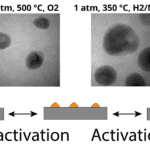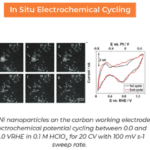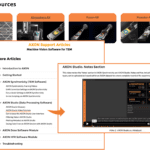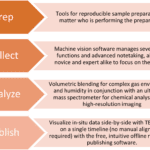
Did you know that reaction conditions, such as elevated temperatures and pressures, can impact the stability of supported-metal catalysts? Are you interested in observing mechanisms of sintering, coking and other processes in real time that reduce the catalyst surface area?
Understanding sintering behavior can improve the design of the catalyst and therefore optimize the stability. With Atmosphere AX from Protochips, you can observe catalyst destabilization at the nanoscale in real time with the TEM, under relevant gaseous conditions and up to 1 atmosphere and 1000°C. So how are you able to observe the stability of your catalyst using our systems?
- Preparation: Sample preparation and deposition are critical but tedious steps in all in-situ TEM experimental workflows. To streamline this process, we’ve carefully designed tools that guarantee precise deposition of your sample onto desired areas on the E-chip as well as verification of sample distribution before assembling the gas cell holder.
- Collection: Once Atmosphere AX is fully set up and TEM-ready, gas flow can be initiated. Both gas flow and heating can trigger sample movement, therefore Atmosphere AX comes equipped with machine vision software, AXON Synchronicity, providing live physical and digital correction as well as metadata indexing and integration.
- Analysis: Once stable reaction conditions are formed, a precise heating ramp can be set. The unique, patented ceramic heating technology of our heating E-chips offers accurate and uniformed heating throughout the viewing area during your experiment ensuring the most reliable results.
- Publishing: Once all the data has been collected and analyzed, data processing can begin. With AXON Studio, researchers can easily filter, plot, sort, create videos and images and visualize trends after an experiment is completed. Since all metadata is integrated into a single software, data correlation and analysis are tremendously accelerated and easily shared.
With this workflow, scaling bulk catalysts experiments to the nanoscale becomes easier, while maintaining the highest level of scientific rigor to publish relevant, reproducible and reliable results.
Want to know more about heterogeneous catalysis using in situ microscopy? Look up our brochure online!
In the video you can see the mechanism of deactivation and regeneration of PtSn intermetallic compound nanoparticle (iNP) catalysts. A reversable transition was observed between decarbonization and regeneration, which directly correlates to the catalyst activity.
Find the whole research paper here:
https://pubs.rsc.org/en/content/articlelanding/2021/cc/d1cc01181b#!









